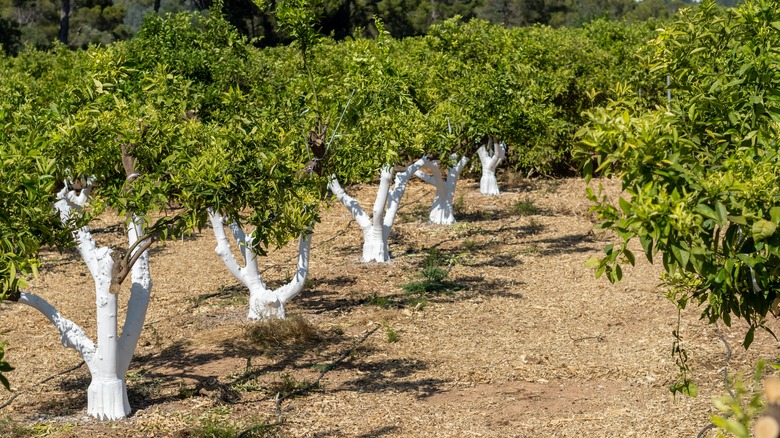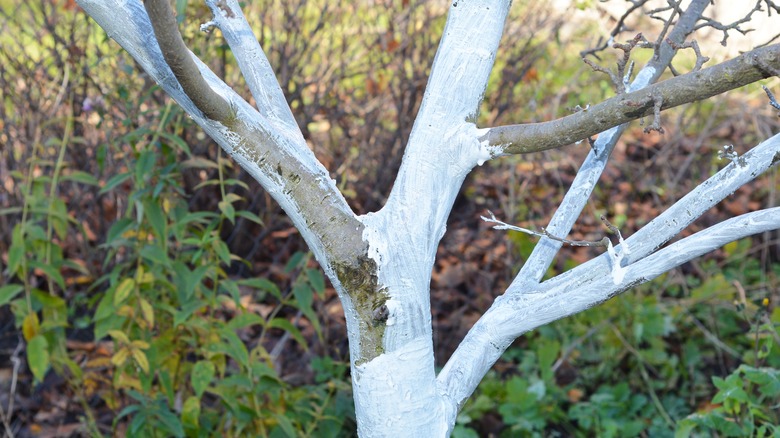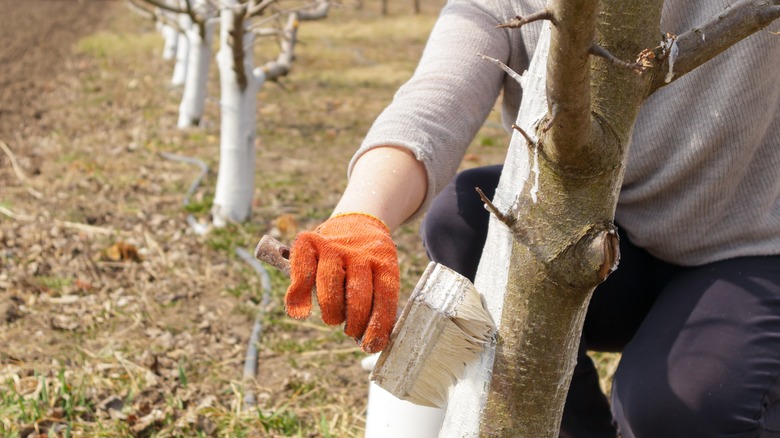What It Means If You See A White Painted Tree
Maybe you've noticed tree trunks painted white while on a walk, driving by an orchard, or somewhere on the internet. This unique practice, which might seem simply decorative, is a time-honored tradition with many benefits for tree health and protection. An agricultural technique with a long track record, it has also found relevance in modern tree care.
Whitewash, traditionally made of water, lime, and salt, has a history dating back to ancient Greece and Egypt, where it was valued for its disinfectant qualities and aesthetic appeal. Throughout the Medieval and Renaissance periods, it was widely used in agriculture and construction for its affordability, reflective properties, and protective benefits against decay and pests. Although its popularity waned with the advent of modern paints, whitewash has recently seen a resurgence due to its natural composition and low environmental impact.
One of the primary reasons for whitewashing tree trunks is to protect them from pests. Certain pests, like boring insects and rodents, can cause significant damage to trees. They gnaw at the bark, lay eggs, and create openings that can lead to infections or weaken the tree's structural integrity. The white paint acts as a physical barrier, deterring pests and preventing them from establishing a foothold on the tree.
Protection against sunscald and frost damage
Young and thin-barked trees, such as fruit trees, are particularly vulnerable to a phenomenon known as sunscald. This condition occurs when the tree bark heats up under the intense sun, leading to the death of bark tissue — similar to a human sunburn. The reflective properties of white paint act like sunscreen and deflect the sunlight. This helps mitigate many damaging sunscald symptoms and preserve the vulnerable tree, typically during the challenging and volatile winter season.
Frost damage is another critical concern in tree care, particularly in regions with fluctuating temperatures, such as New Mexico, Oklahoma, and Texas. The white paint provides much-needed protection and helps regulate the tree trunk's temperature. It prevents the bark from heating up rapidly during sunny winter days, sometimes over 80 or 90 degrees Fahrenheit, and protects it from damage by freezing temperatures later on.
A white backdrop on tree trunks also helps in the process of monitoring for diseases and infestations. With the contrasting background, signs of disease, such as fungal growth, insect activity, or abnormal bark patterns, become far more noticeable. This early detection plays a crucial role in managing tree health, which is especially important for timely intervention and treatment.
Aesthetics and application of whitewash
In addition to its practical benefits, whitewashing trees serves an aesthetic purpose. The uniform white bases of trees create an appealing visual effect for landscaping, enhancing the beauty of gardens, orchards, and public parks. Moreover, whitewashed trees are also more visible, which is helpful for roadside navigation and driving at night. While looks come secondary to the health benefits, whitewash contributes to the overall design of landscaped spaces, giving them a neat and polished aesthetic.
This technique is simple, inexpensive, and the definition of tried and true. The paint used for trees is typically a specialized tree paint or a mixture of white latex paint diluted with water at a half-and-half ratio. The latex paint must be interior and water-based rather than oil-based, enamel, or harsh exterior paint. This formulation ensures the paint is safe for the tree, allowing for normal gas exchange through the bark while providing the necessary protection.
Add salt and hydrated lime if you want to try the old-fashioned recipe. Lime, a by-product of limestone, is a natural alternative to chemical pesticides with no environmental impact — it's also antibacterial, fungicidal, and non-toxic. Limewash or whitewash should be applied on a sunny day for quicker drying and painted from the bottom of the tree trunk up until about 18 inches in height. And voila, the tree is protected for the season! The next time you see a tree painted white, beyond appreciating its striking beauty, you'll know it's well taken care of.



